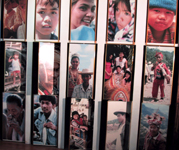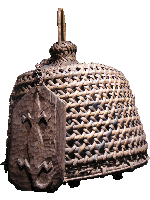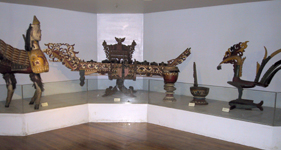The Filipinos and Their Rich Cultural Heritage (Kinahinatnan)
3rd floor, north-east wing gallery

This ethnographic exhibit focuses on the Philippines as land of diversity, crossroads, and a tapestry of cultures. The gallery showcases some regions that have been influenced by migration over the millennia, while others have developed in relative isolation, locked in by the roughness of the terrain and adapting to their distinct environment. These cultural influences, adaptations and response to the environment led to the emergence of major ethnolinguistic groups with many sub-groups. Having a common prehistory and background, all ethnic groups in the Philippines speak languages that belong to the Austronesian family. It is the variety with adaptive techniques and cultural diversity throughout the archipelago that makes the Philippines unique.
Generally, the first part of the exhibit presents the cultural map and collage, the virtual interactive musical instruments allowing visitors to immerse themselves in a virtual world, the origin and the development of writing in the country as well as that of contemporary Philippine languages, tools that ethnographers use to their work and the role of Dr. Jose P. Rizal, Philippine national hero, in Philippine ethnography.

The exciting artifacts displayed in dioramas are in the second segment of the exhibit. This portion in the gallery presents ecological adaptations of the different ethnolinguistic groups in the country. The presentation consists of highlighted graphic maps showcasing the different ecological zones mainly the coastal, lowlands, lake and highlands. Furthermore, each of the above ecological niches, together with the different ethnolinguistic groups representing it, are found in the flip books. The artifacts depicted in each zone tell stories about subsistence, household and communities, symbolism and systems of belief, decorative arts and personal adornments.
The most impressive exhibits are found in the National Treasures Gallery, complemented with the living treasures. Ethnographic specimens that possess outstanding cultural, historical and artistic values represent the rich cultural heritage of the Filipinos. On the other hand, the National Living Treasure legacy is demonstrated by showcasing the selected individual’s outstanding achievement in a traditional cultural art or craft. The recognition of the masters of the traditional cultural arts such as pottery, basketry, weaving and music is bestowed by the National Commission for Culture and the Arts and the inclusion in the UNESCO “Memory of the World Register” of the Philippine Paleographs, four ancient and still used syllabic forms of writing.

The exhibition is also supplemented with the CD-ROM presentation of the Living Treasures and Glimpses of the Ethnic Groups of the Philippines. The two presentations enrich the visitors’ knowledge of the Filipinos and their rich cultural heritage.


